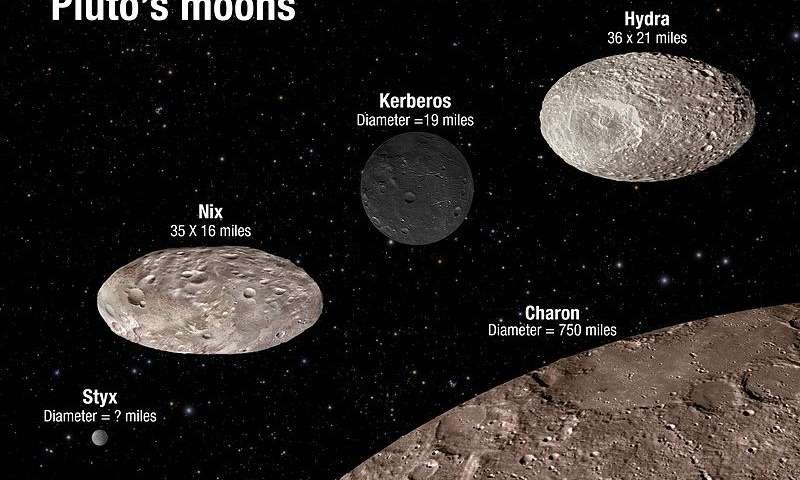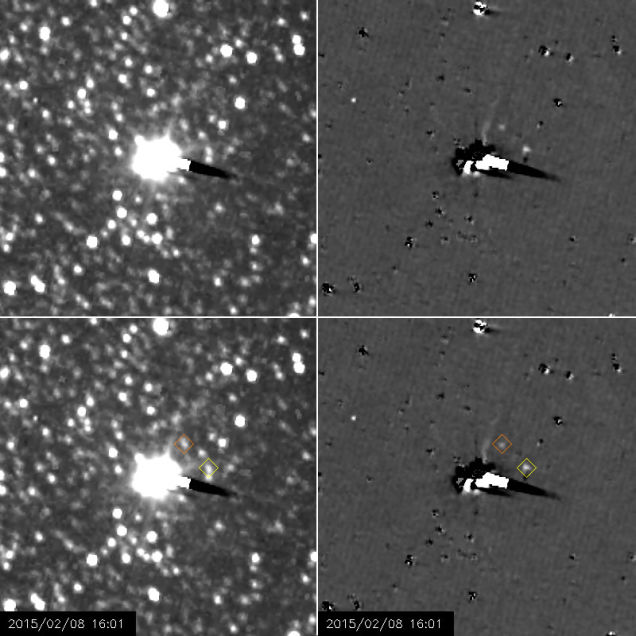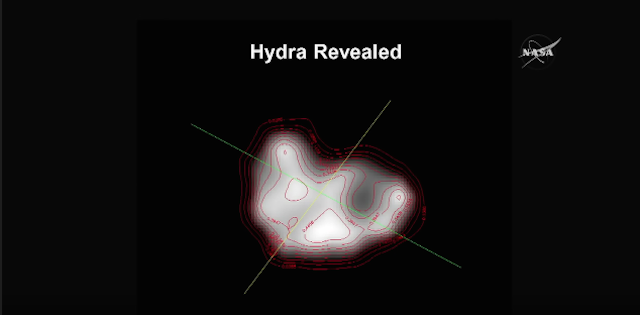Hydra is the outermost of Pluto’s known moons, and until now, we’d only ever seen it as a faint pixel of light. Today, planet Earth gets its first real glimpse of this tiny, enigmatic satellite.
Picture: Hydra approximately 644,000km away from New Horizons, via NASA/JHUAPL/SwRI
This never-before-seen view of Hydra’s surface was captured yesterday at a distance of 645,000km, within hours of New Horizons closest approach on the morning of July 14th, 2015. Captured with the spacecraft’s high-resolution, monochromatic LORRI camera at approximately 3.2km per pixel, we’re literally watching a point of light transform into a bonafide moon. That is a big fucking deal.
For the first time, we know the size of Hydra. It’s about 48km by 33km, a decidedly elongated, lopsided lump of rock and ice. It has an intermediate albedo, a brightness about halfway between Pluto and Charon. That means the surface must be almost entirely icy.
We think that Hydra is either the second or third-largest moon of Pluto, but we won’t know for certain until tomorrow when we get our first high-resolution at the other contender, Nix.
The image above is also the most detailed single-frame image we’ll be getting during the initial series of failsafe downlinks. Hydra was included in the first data downlink early this morning after the New Horizons probe reestablished contact late last night. But this isn’t the last look we’ll get at this little moon. From New Horizons Project Scientist and LORRI science operations lead Hal Weaver: “New Horizons has finally nailed the basic physical properties of Hydra. We’re going to see Hydra even better in the images yet to come.”
Recent Additions to the Pluto Family
Charon might have been the first moon spotted in the Pluto system, but within the past decade, we’ve added four additional satellites to the flock — Nix, Styx, Kerberos, and Hydra. We were already preparing to launch the New Horizons probe to Pluto when Hydra and Nix were discovered in June of 2005 by the Hubble Space Telescope’s ‘Pluto Companion Search Team.’ Kerberos was detected later, in 2011 during a Hubble survey searching for rings around Pluto, while teeny tiny little Styx wasn’t spotted until July of 2012, when the New Horizons team was conducting a search for potential hazards to the reconnaissance mission.
On June 21, 2006, the name ‘Hydra’ was assigned by the International Astronomical Union. Hydra, a nine-headed serpent from Greek mythology, pays double homage to Pluto’s then-tenure as the ninth planet in our solar system (Pluto was reclassified as a dwarf planet in August 2006), with the ‘H’ also indicating its discovery by Hubble.
An Enigma of a Moon… Until Now!
Hydra orbits Pluto at roughly 64,800km from the gravitational center (barycenter) of the system. Its nearly circular, prograde orbit is in the same plane as the moon Charon. Hydra is sometimes brighter than the other oblong moon, Nix, suggesting that it is either larger or that the surface of the moon varies in brightness.
Until the New Horizons flyby, astronomers had no direct measurements of Hydra’s size. We had worked out some very rough size estimates based on the assumption that Hydra is the same brightness as Charon. That assumption, however, would imply Hydra is compositionally very similar to Charon (roughly a 50 / 50 mix of ice and rock), and we really had no good reason to expect that it is. There could be any number of processes — collisions between planetary bodies, different ices or gases siphoned off Pluto — that might make Pluto’s system compositionally diverse, similarly to the moons surrounding Jupiter, Saturn and Neptune.
That Charon, Hydra and Nix are all relatively the same brightness is simply the best guess we were able to make based on incredibly limited information. But with our first real image of Hydra, we can start to make some more sophisticated observations and hypotheses about what this enigma of a moon is actually made of.
Despite the fact that we were really just guessing at Hydra’s size before today, we were correct in supposing the moon isn’t massive enough to form a spheroid under its own gravity. Like Mars’ moon Phobos, Hydra (and Nix) are rather oblong little things:

Zooming in On Hydra
During the New Horizons mission to fly through the Pluto-Charon system, our previous best look at the smaller moons Nix and Hydra was way back in February.

Pluto, Charon, Nix, and Hydra seen by the Hubble Space Telescope in 2006. Picture: NASA/ESA/H. Weaver/A. Stern

Nix and Hydra each orbit Pluto about once a month. Pictures: NASA/Johns Hopkins University Applied Physics Laboratory/Southwest Research Institute

Heavy processing brings out Nix and Hydra more clearly [right] while losing pesky details like background stars[left]. Pictures: NASA/Johns Hopkins University Applied Physics Laboratory/Southwest Research Institute
And her she is again, as revealed moments ago:

Fascinated by Hydra? Hold onto your keyboards, nerds! This is only the beginning. We’ll be getting back even higher resolution images of Hydra in the coming days, and learning much, much more about Pluto’s outermost known moon in the weeks and months ahead. We’ll get our first downlink of Pluto’s other oblong moon, Nix, later tonight.
